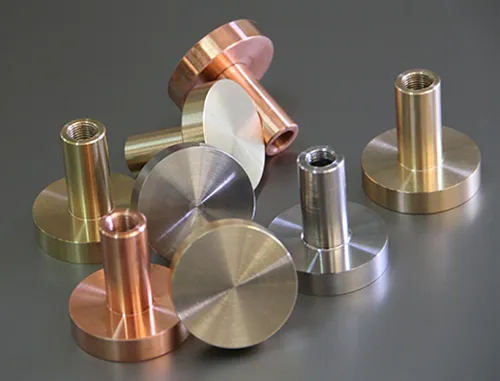Copper CNC Machining -Copper Properties
Copper is a non-ferrous metal closely related to human beings. It is not only rich in natural resources but also has excellent electrical conductivity, thermal conductivity, ductility, corrosion resistance, wear resistance, and other excellent properties. It is widely used in power, electronics, energy and petrochemical, machinery and metallurgy, communications, light industry, emerging industries, and other fields. It is second only to aluminum in the consumption of non-ferrous materials in China.
The types of copper mainly refer to the copper element and various copper alloys, including pure copper (copper element), brass, bronze, white copper, etc.
Precision-machined CNC copper parts are one of the most commonly used CNC machining metal parts. Copper alloy uses are widely to manufacture valves, water pipes, air conditioning connecting pipes, and radiators. They can be found in electrical products, pipelines, the medical industry, and many consumer goods.
Advantages of choosing U-Need copper parts manufacturing
With rich processing experience, U-Need can provide customized machined copper parts, from small batch to large batch processing services, according to your drawings or samples. Fully equipped machining workshops, such as advanced CNC milling machines, lathes, wire cutting machines, spark machines, grinders, and other one-stop machining centers, can ensure your products’ precise dimensions and tolerances. Precision copper parts will be strictly controlled by the comprehensive quality inspection of the manufacturing process inspection and delivery inspection so that you can easily receive high-quality products.
The following are common copper characteristics and uses of various coppe
| Material | Characteristics of Copper | What are copper alloys used for? |
| Beryllium copper | High conductivity, thermal conductivity, high-temperature resistance, wear resistance. | Mold, mold core, and embedded parts require rapid and uniform cooling, especially high thermal conductivity, corrosion resitance, and good polishing. |
| Red copper | It is a soft metal with good plasticity, excellent ductility, conductivity, and thermal conductivity. It can simultaneously be applied to hot pressing and cold pressing and is widely used in electrical corrosion copper products for cables, wires, and electric sparks. High-purity red copper, with fine structure, low oxygen content, no trachoma, pores, and excellent conductivity, is very suitable for electric etching mold. After heat treatment, the electrode has no directivity and is very suitable for a good beating. | The most common use is to make wires. Usually, the wires used today are made of pure copper because their conductivity and thermal conductivity are second only to silver but much cheaper than silver. Moreover, copper is easy to process. It can be made into automobile spare parts and electronic parts by melting, casting, calendering, and other processes to change the shape. |
| Brass | Brass is an alloy of copper and zinc, named after its yellow color. Brass has good mechanical properties and wear resistance. If the constituent elements are only copper and zinc, it is called ordinary brass; If there are more than two elements in brass, including lead, tin, manganese, nickel, iron, silicon, and other elements, it is called special brass. Special brass has high hardness, high strength, and strong chemical corrosion resistance. | Ordinary brass is usually used to manufacture water pipes, valves, and connecting pipes of internal and external units of air conditioners and radiators. Special brass is widely used in condensers, low-temperature pipelines, submarine transport pipes, heat exchangers, and other parts. |
| Bronze | The alloy of copper and tin is called bronze, which is named after its green color. Bronze is the earliest alloy in China, commonly used in ancient times (such as the Bronze Age in China). The original meaning of bronze is a copper-tin alloy. Later, for the convenience of management, all copper alloys except white copper and brass are uniformly called bronze, and the names of the main added elements are added in front to distinguish different kinds of bronze. Bronze generally has good corrosion resistance, abrasion resistance, castability, excellent mechanical properties, and high hardness. Bronze also has an abnormal characteristic – heat shrinks and cold expands, which is used to cast statues. After cooling, it expands to make eyebrows clearer. | Bronze is used to manufacture precision bearings, high-pressure bearings, marine mechanical parts resistant to seawater corrosion, and various plates, pipes, bars, etc. In addition, tin bronze with tin as the main addition element has excellent casting performance, good mechanical performance, and friction-reducing performance, which is very suitable for manufacturing turbines, gears, and bearings. Lead bronze is now used as bearing material in engines and grinders. Aluminum bronze has excellent wear resistance, corrosion resistance, and high strength and is widely used in manufacturing high-load shaft sleeves, gears, marine propellers, etc. Phosphor bronze has good conductivity and high elastic limit and is very suitable for manufacturing precision springs and electrical contact elements. |
| Cupronickel | White copper has excellent mechanical and physical properties, good ductility, high hardness, beautiful color, corrosion resistance, and deep drawing performance compared to other copper alloys. | It is widely used in shipbuilding, petrochemical, electrical appliances, instruments, medical devices, daily necessities, handicrafts, and other fields, and it is also an important resistance and thermocouple alloy. |
| Chrome copper | It is widely used in shipbuilding, petrochemical, electrical appliances, instruments, medical devices, daily necessities, handicrafts, and other fields, and it is also an important resistance and thermocouple alloy. | It is mainly used as the electrode for spot welding or seam welding low carbon steel and coated steel plate, as well as the electrode holder, shaft, and gasket material for welding low carbon steel, or as the large mold and fixture for projection welding machine, mold or inlaid electrode for stainless steel and heat-resistant steel. Beryllium copper has also been replaced as a general mold material in the mold industry. For example, shoe sole molds, plumbing molds, and plastic molds generally require high smoothness, connectors, guide wires, and other products that need high-strength conductors. |

